Pigs of the open plains
by Ron and Viv Moon
Hunter 3
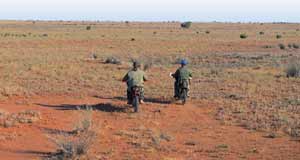
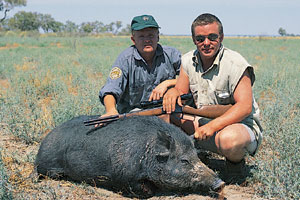
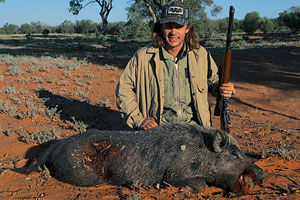
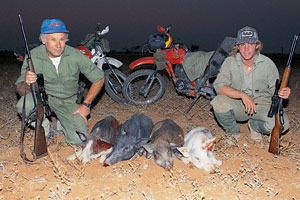
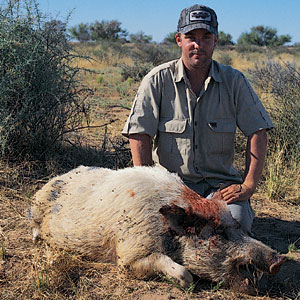
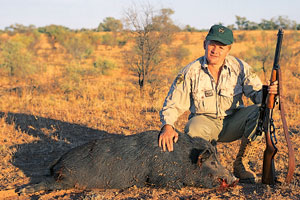
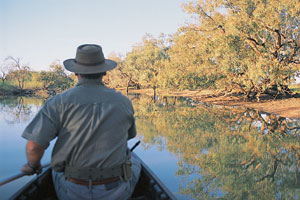
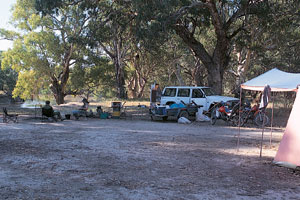
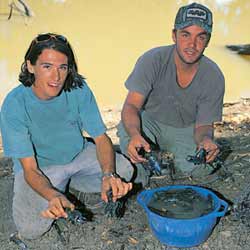 The soft ground underfoot muffled our footsteps as we slowly walked
through the mix of spindly box trees and sparse lignum bushes. This was
top pig country, being a winding narrow peninsula of land between the
swamp and flooded lakebed and the creek that fed it. To my left the
wide stream of open water was alive with pelicans, cormorants and
ducks, while to my right a few hundred metres the scrub becomes near
impenetrable with young box trees and lignum growing in wild profusion.
Even in this relatively open country, visibility was restricted to 60
to 80 metres at best and we knew that when we came across the pigs,
contact would be close and the action fast and furious.
The soft ground underfoot muffled our footsteps as we slowly walked
through the mix of spindly box trees and sparse lignum bushes. This was
top pig country, being a winding narrow peninsula of land between the
swamp and flooded lakebed and the creek that fed it. To my left the
wide stream of open water was alive with pelicans, cormorants and
ducks, while to my right a few hundred metres the scrub becomes near
impenetrable with young box trees and lignum growing in wild profusion.
Even in this relatively open country, visibility was restricted to 60
to 80 metres at best and we knew that when we came across the pigs,
contact would be close and the action fast and furious.
Ian’s raised hand, indicating ‘pigs ahead’, had me turning his way while he slipped behind the cover of a few thin trees waiting a few seconds for me to get into position. The pigs, five that were visible, were feeding unconcernedly, their snouts digging and upturning the soft earth in their quest for an early morning feed.
I raised the hammer of the Marlin 30/30 to full cock, brought the Tasco 4X up to the eye, picked up the shoulder of a burrowing pig and squeezed the trigger. The crack of the Winchester 170-grain Silvertip brought the peace to an end and in a blink of an eye all was pandemonium. Birds lifted from their roosts and squawked their way into the air in a cacophony of sounds. ’Roos feeding unseen among the thicker scrub took off, their bounding, pounding backs only given away by their sudden movement and the noise of their feet splashing through the shallow waters bordering the lake.
The pigs - all but the two we had shot - bolted. Four more unseen ones burst out of a patch of thick scrub just to my right and I picked up the running frame of a big sow as she dodged through the scrub. I sent a bullet her way but she was too quick. I levered another round into the chamber only to see the animal stumble and fall to one of Ian’s shots. Further out, a half-grown animal was fast closing with the thicker scrub and I sent a soft nose out looking for a Texas heart shot, the solid thump telling me I had made a good hit.
I ran a few metres trying to get a clear shot of another pig, but they had vanished. I wished for the bikes we had left behind. But this was better, maybe not as efficient, but just as exciting and a little more challenging.
During the past dozen years or so I’ve been lucky enough to hunt my fair share of pigs out on the western plains of NSW and it’s something I never tire of doing. Of course, we do a lot of walking but in fact, our day is very much a mix of riding and walking. Sometimes after the Darling River has come down in a big rush of water and all the flood-out channels have been filled, we’d load the canoe up and go hunting that way. The boat has got us into country that was otherwise inaccessible - and then we got pigs.
Generally, the day kicks off well before daylight when yours truly crawls out of a sleeping bag, yells at the others and kicks the fire into life. Sleepy eyes throw on clothes, grab a quick cup of coffee and fire the bikes into life. Five minutes later you are wide awake, the cool breeze on the face seeing to that.
Our camp on the banks of the Darling is right in pig country and we have shot pigs within a kilometre of camp and on this most recent trip we weren’t disappointed.
Two mornings in a row we came across pigs in the open; the first group grazing unconcernedly as we slipped from the bikes, snuck through an intervening fence and stalked up to them. The old sow leading the group stopped twice, wary, having heard our bikes, but with the wind in our favour, she looked, smelt the air and, satisfied no danger was close, continued to feed along the edge of the low sand ridge that we had used to cover our approach.
Hunkered down behind some fallen timber, we waited as the eight pigs grazed towards us, closing the gap from 200 metres to 100...then 70...then 50 metres. I looked at my son Trent - it was his call, as he had seen them first and still he waited. Nine months working with a hunting guide in Africa the year before has given him an edge over his old man and he wasn’t going to blow this one.
Finally, at 15 metres he stood up, dropping the lead pig with the first shot. We began to fire, as pigs scattered in all directions. There were no survivors. We took the backstraps, slipping them into a plastic bag on the bikes and headed further afield.
By 9.30 am, whether we’re walking or riding, we are heading back to camp for a late breakfast and a few hours resting around camp. A bike might need some repairs or we’ll go for a swim or try our hand at some varmint shooting on the crows.
By 4pm we’re firing up the bikes again for another run and this takes us into darkness and, while we always plan to be back on a main track by the time the sun drops below the horizon, often we get caught out and it’s a slow ride back across country to a track where we can lope along at a reasonable speed. Most times however, we’re back in camp an hour or so after sundown, but if we’re right on the opposite side of the property it could be later.
During our first sojourns on this vast 180,000ha spread we had been navigationally embarrassed on more than one occasion and at times like those you need a map and a compass or a GPS. Now that we know the property pretty well, we rarely need such nav aids but still carry them just in case.
While there are a lot of pigs in far western NSW, there’s generally an awful lot of country for them to be spread across. For those afternoon runs, we rarely go on foot for we have found that the pigs are still just starting to move and most need to be flushed out of their day resting spots, whether that’s in the lignum or the cane grass. If we do dismount, it’s generally to sweep through a real dense patch of lignum for five to 15 minutes to see if we can push anything out, then it’s on the bikes to hit the next patch of cover.
It’s surprising though how many pigs we find far from water, tucked up under a tree on a sand ridge or laying up in patches of dry cane grass that dot the vast sand plains of this region of NSW. It’s these patches of cane grass that provide some of the most exciting hunting and some of the most game.
We check the wind, using that if we can, and if there is a tank or dam at one end of a patch of cane grass, which there often is, we work towards that in line abreast, spread out over the width of area of grass.
It’s a matter of standing on the footpegs, watching where you are going, just a metre or so in front of the bike, while keeping an eye out for any pigs that you can flush. Then, when a pig or pigs are spotted, it’s on for young and old as engines rev and you take off after the fast moving animals as quickly as possible. It also pays to keep an eye on your companions and listen for a yell or a change in an engine note, which indicates contact has been made and a chase is on.
At times like these, it’s easy to come a cropper and on a previous trip, Ian had dropped his bike into a deep, metre-wide hole, being ejected over the front handlebars in the process and into a patch of grass and churned up rock-hard dry mud. His face wore the scars of his endeavours for a couple of weeks after that, but still it doesn’t do much to our ardour when the blood is up. Mind you, such tumbles are the main reason we have shifted from carrying our rifles with a sling over our back to carrying them in a saddle mount - a possibly slower system but a darn sight safer one.
If the cane grass is extensive, and the property we hunt on has patches up to more than 100ha in size, there is a good chance that whatever pigs you see will only be flushed from the cover the cane grass affords by hard and constant pressure. We often have pigs that we have stirred up, turn and go around us and if, as is the case more than once, we flush a big mob, most will stay in the cover while we concentrate on just one, two or three animals.
Generally, by the time the pigs break from the dense cover they are 50 to 150 metres in front. In the more open country if you are on the bikes you can close the gap quickly and, judging when the time is right, drop the bike in a flurry of dust and dirt, step off, slip the rifle from the side saddle, lever a round into the action, throw the rifle to the shoulder, find the fast-running target and send a round thundering after them. It is snapshooting at its best and a quick eye, instant reflexes and a steady arm are a big plus.
Standing still, if the first few rounds don’t find their target, the range quickly lengthens. It is then that any of our crew that is still on a bike has a chance to close the gap and have a go, leaving those that have started the foray to struggle with a quickly dropped bike, that has often flooded, kick it into life and begin, what is by then a generally futile chase, all over again.
We all use lever actions most of the time, Marlins, generally in 30/30, but not exclusively, and if we are walking the lignum we may un-lumber a .44 Winchester lever action, which packs a mighty wallop at ranges out to 100 metres. We load much of our ammo but keep coming back to Winchester 170-grain Silvertips or Remington 170-grain Core-Lokt soft point bullets and have found both rounds to be extremely effective on big and small pigs, mud-covered or not.
Our hunting trips are generally for a week and even then they are too short. All I know is that at the end of each trip, all I want to do is go back and start again. But that’s the way hunting should always be.
